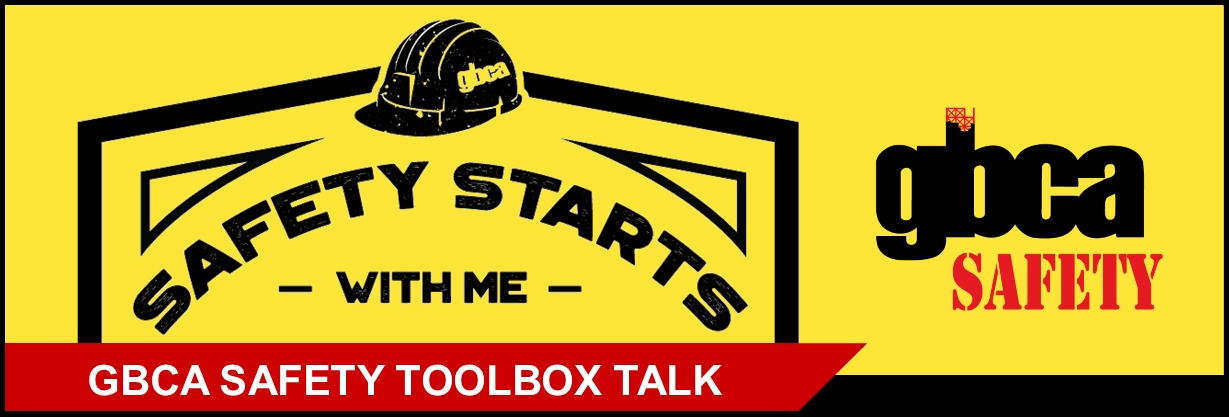This GBCA Safety Toolbox Talk discusses the distinction between isolation and quarantine in relation to COVID-19 response (Updated December 3, 2020). Click below to download the Toolbox Talk as a handout (includes Sign-In Sheet).
COVID-19: Isolation and Quarantine
Currently, there is no FDA-approved vaccine or treatment for COVID-19. Because of this, humans are highly susceptible to being infected and getting sick. To help reduce the spread of COVID-19, the Centers for Disease Control and Prevention recommend isolation and quarantine to prevent further exposures to the virus. This toolbox outlines both isolation and quarantine and reviews the recommended responses to COVID-19 exposure for individuals. (Updated December 3, 2020)
Isolation separates sick people with a contagious disease from people who are not sick. If you are sick, you isolate to prevent infecting others.
Quarantine separates and restricts the movement of people who were exposed to a contagious disease to see if they become sick. You quarantine because you might get sick or may already be sick and contagious.
Isolation Recommendations
The recommended time for isolation of people with COVID-19 is at least 10 days from the date that symptoms first appear. Isolation lasts until the following conditions:
- At least 10 days since symptoms first appeared AND
- At least 24 hours with no fever WITHOUT fever-reducing medications AND
- Other symptoms of COVID-19 are improving. **Loss of taste and smell may persist for weeks or months after recovery and need not delay the end of isolation.
Isolation can last longer than 10 days from the date of first symptoms if the other two conditions are not met.
When you isolate, stay at home except to get medical care:
- Monitor your symptoms. If you have an emergency warning sign (including trouble breathing), seek emergency medical care immediately
- Stay in a separate room from other household members, if possible.
- Use a separate bathroom, if possible.
- Avoid contact with other members of the household and pets.
- Don’t share personal household items, like cups, towels, and utensils.
- Wear a mask when around other people, if you are able to.
Quarantine Recommendations
The recommended time for quarantine of people who have been in close contact with someone who has COVID-19 (excluding people who have had COVID-19 within the past 3 months), or who have traveled to known COVID-19 hotspots, is at least 14 days from the last contact with COVID-19 or date of travel.
The following situations count as close contact:
- You were within 6 feet of someone who has COVID-19 for a total of 15 minutes or more
- You provided care at home to someone who is sick with COVID-19
- You had direct physical contact with the person (hugged or kissed them)
- You shared eating or drinking utensils
- They sneezed, coughed, or somehow got respiratory droplets on you
If you are caring or living with someone with COVID-19 (in a situation where you cannot completely isolate from them), then the 14 day quarantine period starts AFTER the COVID-19 positive person completes their isolation period (see above for the conditions for isolation).
If you develop symptoms of COVID-19 during your quarantine and test positive for COVID-19, switch to and start the recommended time for isolation.
- For example, if you develop symptoms of COVID-19 on day 12 of your quarantine and receive a positive test for COVID-19, this day will count as the first day of isolation, meaning that you will be in quarantine and isolation for at least 22 days (12 days of quarantine + at least 10 days of isolation).
When you quarantine, stay at home and monitor your health:
- Stay home for 14 days after your close contact or travel to a hotspot.
- Watch for fever, shortness of breath, cough, or other COVID-19 symptoms.
- If possible, stay away from others, especially people who are at higher risk for getting very sick from COVID-19.
Options to Reduce Quarantine
The CDC offers two options to reduce quarantine for individuals without symptoms after close contact exposure or travel to a hotspot:
- On day 10 without testing.
- On day 7 after a negative test result for a test taken no earlier than day 5.
After stopping quarantine, you should,
- Continue watching for symptoms until 14 days after exposure.
- Immediately isolate if COVID-19 symptoms appear and contact your medical provider.
- Continue wearing a face mask, practicing social distancing, avoiding crowds, and washing your hands frequently.
Returning to Work
We recommend staying home if you have any symptoms. Contact your medical provider to get a test to distinguish between COVID-19 and flu. You can be positive for COVID-19 and flu at the same time. You should stay home if you have the flu.
Contact your supervisor. Employers may have specific requirements before you may return to work after isolation or quarantine due to COVID-19 exposures
Remember to record the attendees of your toolbox talk!





